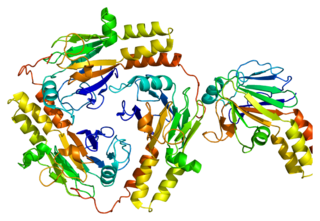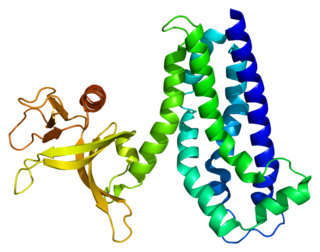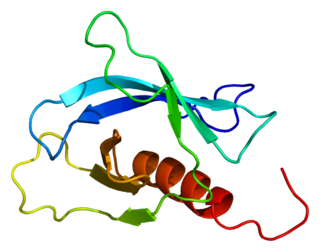Related Research Articles
Small GTPases, also known as small G-proteins, are a family of hydrolase enzymes that can bind and hydrolyze guanosine triphosphate (GTP). They are a type of G-protein found in the cytosol that are homologous to the alpha subunit of heterotrimeric G-proteins, but unlike the alpha subunit of G proteins, a small GTPase can function independently as a hydrolase enzyme to bind to and hydrolyze a guanosine triphosphate (GTP) to form guanosine diphosphate (GDP). The best-known members are the Ras GTPases and hence they are sometimes called Ras subfamily GTPases.

Mothers against decapentaplegic homolog 1 also known as SMAD family member 1 or SMAD1 is a protein that in humans is encoded by the SMAD1 gene.

FYVE, RhoGEF and PH domain-containing protein 1 (FGD1) also known as faciogenital dysplasia 1 protein (FGDY), zinc finger FYVE domain-containing protein 3 (ZFYVE3), or Rho/Rac guanine nucleotide exchange factor FGD1 is a protein that in humans is encoded by the FGD1 gene that lies on the X chromosome. Orthologs of the FGD1 gene are found in dog, cow, mouse, rat, and zebrafish, and also budding yeast and C. elegans. It is a member of the FYVE, RhoGEF and PH domain containing family.
The EGF module-containing Mucin-like hormone Receptors (EMRs) are closely related subgroup of G protein-coupled receptors (GPCRs). These receptors have a unique hybrid structure in which an extracellular epidermal growth factor (EGF)-like domain is fused to a GPCR domain through a mucin-like stalk. There are four variants of EMR labeled 1–4, each encoded by a separate gene. These receptors are predominantly expressed in cells of the immune system and bind ligands such as CD55.
The Retinoic Acid-Inducible orphan G-protein-coupled receptors (RAIG) are a group of four closely related G protein-coupled receptors whose expression is induced by retinoic acid.

Zinc finger protein 3 is a protein that in humans is encoded by the ZNF3 gene.
Brain-specific angiogenesis inhibitors are G-protein coupled receptors belonging to the class B secretin subfamily. Members include:

RhoGEF domain describes two distinct structural domains with guanine nucleotide exchange factor (GEF) activity to regulate small GTPases in the Rho family. Rho small GTPases are inactive when bound to GDP but active when bound to GTP; RhoGEF domains in proteins are able to promote GDP release and GTP binding to activate specific Rho family members, including RhoA, Rac1 and Cdc42.

A-kinase anchor protein 13 is a protein that in humans, is encoded by the AKAP13 gene. This protein is also called AKAP-Lbc because it encodes the lymphocyte blast crisis (Lbc) oncogene, and ARHGEF13/RhoGEF13 because it contains a guanine nucleotide exchange factor (GEF) domain for the RhoA small GTP-binding protein.

Dedicator of cytokinesis protein 1 (Dock1), also (DOCK180), is a large protein encoded in the human by the DOCK1 gene, involved in intracellular signalling networks. It is the mammalian ortholog of the C. elegans protein CED-5 and belongs to the DOCK family of guanine nucleotide exchange factors (GEFs).

Triple functional domain protein is a protein that in humans is encoded by the TRIO gene.

AT-rich interactive domain-containing protein 3B is a protein that in humans is encoded by the ARID3B gene.

Olfactory receptor 5AS1 is a protein that in humans is encoded by the OR5AS1 gene.

Gamma-aminobutyric acid receptor subunit rho-2 is a protein that in humans is encoded by the GABRR2 gene.

Zinc finger FYVE domain-containing protein 1 is a protein that in humans is encoded by the ZFYVE1 gene.

FYVE, RhoGEF and PH domain-containing protein 3 is a protein that in humans is encoded by the FGD3 gene.

FYVE, RhoGEF and PH domain-containing protein 4 is a protein encoded in humans by the FGD4 gene.

Guanine nucleotide-binding protein subunit alpha-12 is a protein that in humans is encoded by the GNA12 gene.

FYVE, RhoGEF and PH domain-containing protein 2 (FGD2), also known as zinc finger FYVE domain-containing protein 4 (ZFYVE4), is a protein that in humans is encoded by the FGD2 gene.

Within mammalia, TMEM239 orthologs are found in organisms belonging to eutheria and metatheria, but not prototheria. No human paralogs for TMEM239 have been identified.